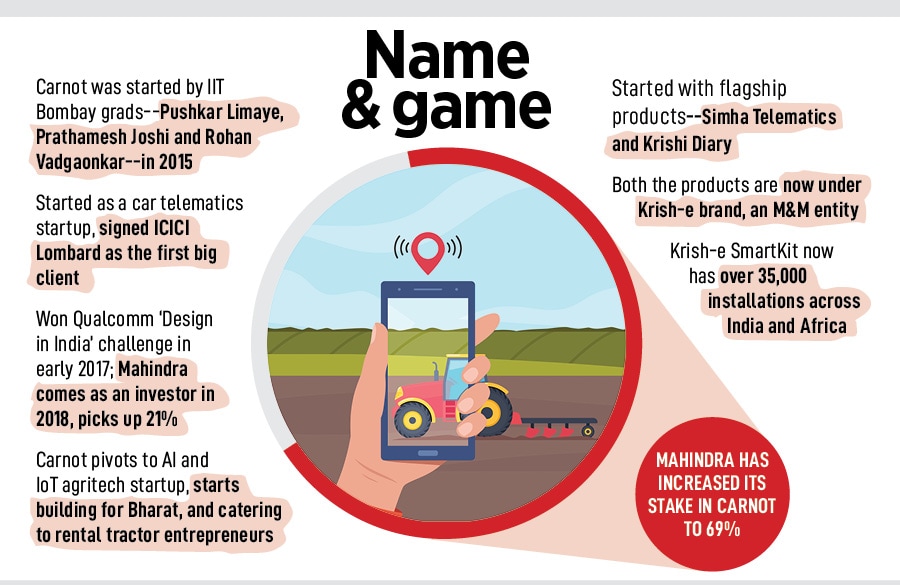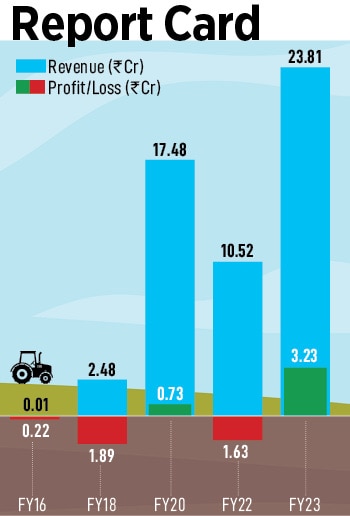Car, Samosa, Tractor: Carnot & its ride with Mahindra
How a mechanical engineer and his IIT-Bombay friends used AI and IoT to make tractors smart, profitable, and ended up driving M&M's farming vertical


May 2015, Mumbai. It started with a passionate, resounding and clarion call: Kar lete hain, kood jaate hain (let’s do it, let’s take the plunge). After working in a well-funded startup for over six months, three young IIT-Bombay grads realised they were misfits. And the reasons were unconventional. “We saw how a startup must not be run," recalls Pushkar Limaye, who hails from a family of chartered accountants in Mumbai, spent the first 10 years of his life in a 150 square feet house shared by eight inhabitants, and completed his higher secondary education from a Marathi-medium school. “I wanted to continue with my family tradition of CA, but my father advised me against it," he smiles. His friends were preparing for IIT, he too did, and was pleasantly surprised with the ease with which he cleared. “There was no pressure. I joined IIT-Bombay in 2010," he adds.
On the first day of IIT, the young undergrad realised the meaning of ‘pressure’. “Everybody was talking and introducing themselves in English," recalls Limaye. “I was a misfit. I avoided talking." Over the next few weeks, Limaye started learning the language, but there was one big and instant lesson: Technology cut across communication barriers. “I mean, build circuits, write code…for an introvert like me, technology was a safe refuge," he underlines. “I loved it."
Over the next three years, Limaye found another love in the racing team of IIT-Bombay. He spearheaded the development of an all-terrain vehicle, took part in national competition, and topped it. The next target was foreign turf in the UK. And here came the next big learning. “There was a big disconnect in the theoretical world of engineering and the practical world," he recalls.

Back in Mumbai in 2015, there was a growing disconnect. Limaye and his friends--Prathamesh Joshi and Rohan Vadgaonkar—decided to quit their jobs and turn entrepreneurs. The first idea was to build EVs (electric vehicles). The plan of making debut in a capital-intensive industry--which meant raising loads of money—was nixed. Reason was the poor experience which came from a stint as an employee at a startup. The big VCs were there, the tech venture had money, but they didn’t know technology. “They could not even fix a basic thing in tech and were talking about opening shops in Germany and Singapore," he recalls. “We never wanted to get into such a business." All friends listened to their hearts and decided to start a hardware venture of car telematics. “After all, we built cars (prototypes) at IIT, came among the top 20 in global competition and we know telematics," argued Limaye. “We were made for the hardware business."
The friends started Carnot, got into the business of plug-and-play device for cars, and after six months got angels in Sandeep Tandon and Kunal Shah who pumped in Rs 1.5 crore each. Carnot did three things for urban car owners. First, it showed location and trip history. Second, it had a cool drive score, much like what Fitbit does today. And third, the device had an in-built gamification feature. “It was the coolest product in the town," he says. The friends sold a lot of devices, roped in ICICI Lombard as their big client, and it looked like a smooth ride.

Then came the bewitching turn around the corner, and the friends realised the hard side of the hardware venture. “It was a nightmare," recalls Limaye, co-founder and chief technology officer of Carnot. In the software business, the CTO explains, when you have a bug, you fix them. “It’s normal," he adds. In hardware, on the other hand, if one misses something, then it’s over. The friends had completed a manufacturing run of Rs 50 lakh worth of inventory in Chennai, and problems started cropping up. From floods to typhoons to workers’ agitation to hardware bugs, you name a problem and Carnot had it. There was only a few months of runway left, and eight employees, including the three co-founders, had not drawn salaries for six months. “It was a terrible nightmare," he says.
A year later, in 2018, came a ‘rustic’ nightmare. “Kahan kood gaye yaar (what have we taken the plunge into)," Limaye freaked out. It was Sultanpur in Uttar Pradesh. “Bhaiyaaon aur behnoon, aao aur chai samosa khao (brothers and sisters, please come and have tea and samosa)," screamed a man from a megaphone in a small dusty village where Mahindra & Mahindra was organising an event to felicitate tractor owners and cement their bonding with them. Carnot had made a transition from car telematics to tractor telematics after getting Mahindra as an investor, and the core team of Carnot relocated to Lucknow to get a pulse of Bharat (rural India) and understand their new set of consumers. The young men from the city realised it was not the tractors cylinders which were on fire. “There were gunshots all around us. We saw rifles for the first time," recalls the first-generation entrepreneur who saw people getting agitated over rasgullas and gulab jamuns.

In fact, the gunfire had a ‘sweet’ beginning. Rasgulla, which was ordered for villagers, got over. The replacement, which came in the form of gulab jamun, irked the visitors who found the substitute insulting. “If other villages got rasgullas, then why should we not get it," was the innocuous argument of the one set of villagers who came late to the event. “They fired in the air to protest and then went back," recalls Limaye.
Though the incident left a bad taste in his mouth, there was a sweet learning, and an ‘aha’ moment. Carnot team got to know what to build, and who to cater to. “There were millions of tractor rental entrepreneurs, and they were invisible," recalls Limaye. Over his interaction with scores of villagers over a few months, the Carnot founders realised the farmers, who owned a tractor, were dealing with a massive but unnoticed problem. “Do you know what it means to run a taxi without a meter or to be in a cab which doesn’t have navigation," he asks. The poor tractor owners, he explains, used to give their vehicles on rent, but didn’t know how to charge and what to charge. There was nothing in the market which could help in automatic area detection or land size detection. “We got our users, we got our problem statement, and we started building for tractor rental entrepreneurs," says Limaye.
Fast forward to June 2023. Simha Kit and Krishi Diary—the two flagship products of Carnot—had been seamlessly integrated into the farming ecosystem of Mahindra, which has increased its stake to 69 percent. The investment in Carnot, underlines Ramesh Ramachandran of M&M, brings world-class digital and technology capabilities to Mahindra. “Carnot drives the technology platform for Krish-e, which is M&M’s farming as a service (FaaS) vertical," points out the senior vice-president, and head of Krish-e.
“Carnot fit the bill perfectly," says Ramachandran. The startup pivoted from solving IoT problems in the auto industry to doing the same for the farming industry. Along the way, he points out, the founders demonstrated a unique ability to develop high-tech and world-class solutions for Bharat. “What they have built is simple, intuitive, affordable and has patented technology under the hood," he says, adding that Carnot has installed the IoT solution in over 33,000 tractors and other farm equipment across the world. “They are tracking farm work across millions of hours and millions of acres," he adds.
Ramachandran tells us how he has keenly tracked Carnot’s journey in the Mahindra ecosystem. When Mahindra made its maiden investment, the company was convinced that Carnot could build a world-class IoT solution. Over time, the auto major realised the startup was well suited to develop and manage the full Krish-e stack encompassing IoT, AI, process automation, farmer apps, analytics and all new-age technology requirements. “That vision is being played out. And in this context, M&M decided to take a majority stake in Carnot," he underlines.

Back in 2018, Limaye and his friends were getting to pitch to Pawan Goenka, who was then managing director of M&M. The co-founders were nervous. There were two reasons. First was natural. The startup entrepreneurs thought the MD would be intimidating. Second reason was also natural. Carnot had been in talks with two sets of strategic investors. “We knew we needed patient capital. Hardware is not an instant coffee business," says Limaye. While an OEM which was supplying to Hero MotoCorp was the first potential suitor, second happened to be M&M. Limaye knew Mahindra had a telematics team.
Meanwhile, the pitch started, and ended abruptly after 10 minutes. Limaye thought he had goofed up. “Aur IIT main kya chal raha hai (what is happening in IIT)," was how Dr Goenka continued the conversation. “Don’t worry. I won’t grill you. I have heard about you guys," he said. In 2017, Carnot was one of the three winners of the prestigious ‘Design in India’ competition organised by Qualcomm. “I think he knew this," says Limaye, who chatted with the MD for the next 30 minutes, and the topic was just one: IIT. “He is an IIT-Kanpur grad," says Limaye.
An IITian and eight years into the journey, how does it feel to be an entrepreneur in an era when grads from IIT and IIM are known to get easily funded, and there are many running a unicorn and soonicorn ventures? “Do you guys see yourselves as misfits," I ask. Limaye pauses for a while, and confesses that it has not been an easy journey. What has made it difficult, though, has been the honesty of the co-founders. When Carnot was into car telematics, he says, the founders could have easily sold the grand vision of a device in every car across the world and raised loads of money. “We didn’t. We knew it’s a false narrative which will have a painful ending," he says, adding that the co-founders were clear about two things. First, Carnot was not an IPO-type business. So, no point playing that game. Second, it was a hardware business, which needed years of patience. “Agritech is not an easy segment to be in," he says, pointing out his one big learning.
“Is there any other learning," I ask. “If you again get a chance to start up, how would it be different from the first stint," I probe. Limaye first tells us what won’t change. ‘We will never go after valuation and mindless raising of money," he says. Now he tells us what he won’t do. “As a founder, I have been too hard on myself," he says, adding that he was always under the impression that growing up means not taking care of oneself, and always thinking about others. “I was wrong," he says. I can"t blame myself for everything wrong and give credit for everything good to someone else, he underlines. “So if I start again, I will take care of myself," he signs off.
First Published: Jun 28, 2023, 14:59
Subscribe Now